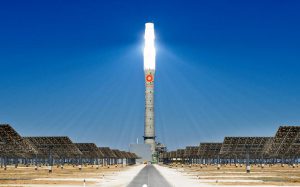In 2016, when SolarReserve connected its 110 MW Crescent Dunes solar thermal power plant in the state of Nevada, it reached its peak as a company. But the enjoyment of reaching that peak could not be prolonged. And having spent almost four years from that moment, the company filed its bankruptcy a few months ago. And a few days ago, all activity ceased permanently.
How has this radical change been reached? Well, at the end of the same year 2016 they already started announcing failures that forced them to close the plant promptly. Looking back today, those problems have not come to solve them on any occasion. To this, it should be added an unsuccessful management that has led to a lack of liquidity of the company, which led them to sell their only American asset, and the only one that gave them benefits, as well as their concentrating solar power projects in other countries. We are talking about Aurora in Australia and Likana in Chile.
And not even with all these sales did all the losses be rectified.
Luis Crespo, president of Protermosolar, spoke about the problems that led to this borderline situation. “This company only had the Crescent Dunes concentrates solar power plant in operation but had had many problems in recent years. These problems were of two types, design and operation, leaks in one of the tanks filled with molten salt caused the closure of this plant of more than 1,000 million euros and had to be disconnected several times. In addition, SolarReserve took a lot of risk in international markets and did not manage his economic capacity well. So, after a year in bankruptcy proceedings, he had to close».
Kevin Smith was the CEO of the company. And he left the ship a year ago.
Crescent Dunes had a molten salt energy storage technology developed in the United States. And it was one of the only companies that worked through a central or central heliostat tower system with tracking. These are an extension of 1.2 million square meters of glass, more than 1,000 tracking mirrors, which look and throw the energy of the sun towards its receiver, a tower 200 meters high.
Therefore, last October, the public administration took control of the Board of the entity linked to SolarReserve, Tonopah Solar Energy. This was an attempt to close Crescent Dunes after it was known that NV Energy broke the agreement due to the lack of performance of the plant. Since the leakage of salt tanks came to have it closed for more than eight months.
What consequences will the disappearance of the US solar thermal company have?
Luis Crespo emphasizes that it is an isolated problem of this company. “It is true that news like this could harm this technology but what has happened to Crescent Dunes is a unique case. In Spain we have examples of success for a decade of similar models, such as Gemasolar, of the Spanish SENER, the world’s first solar thermal power plant in commercial operation to use the technology of tower and molten salt storage systems promoted by the company Torresol Energy. It has been able to link up to 36 continuous days of power generation thanks to its storage system, which allows it to produce electricity without interrupting it at night and which becomes the diferencial differential factor ’of this plant.”

The continuous problems of the plant were not the only reason for the closure, since the plant never reached its expected production per month. So S&P Global Platts said that the solar thermal had only achieved a capacity factor of 0.3% in the second quarter of 2019. With a delivery of 765 MWh to the grid. Data lower than promised.
About this, the head of Protermosolar, settled the issue as follows: “Despite Crescent Dunes, the technology of central tower or heliostats is perfect in latitudes of the US, northern Mexico, southern Spain, northern Africa and China , while parabolic trough technology, the most widespread fits more in areas with more radiation, such as Dubai, India or South Africa.»
Spanish technology is revaluing worldwide. In the US, the disappearance of the solar thermal system leaves BrightSource as the only promoter of solar thermal plants with experiences in the country. Since eSolar disappeared beyond 2017.
For its part, BrightSource, which has a low profile in the US, has refocused its efforts in foreign markets and especially in a single project. This is a 121 MW CSP project called Ashalim in the Negev desert of Israel.